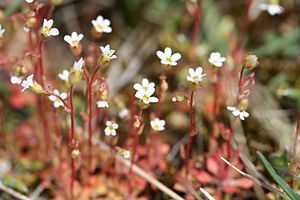Three-fingered saxifrage
| Three-fingered saxifrage | ||||||||||||
|---|---|---|---|---|---|---|---|---|---|---|---|---|

Three-toed Saxifrage ( Saxifraga tridactylites ) |
||||||||||||
| Systematics | ||||||||||||
|
||||||||||||
| Scientific name | ||||||||||||
| Saxifraga tridactylites | ||||||||||||
| L. |
The three-finger-saxifrage ( Saxifraga tridactylites ), and finger-saxifrage called, is a flowering plant in the family Saxifragaceae (Saxifragaceae).
features
The three-toed saxifrage is an annual plant . The stem is loosely branched, reaches a stature height of 2 to 18 cm and is usually conspicuously red in color. The stalked basal leaves are arranged in a rosette and have entire or three-lobed margins and are already dried up at the time of flowering. The stem leaves are clearly three-lobed and thick-fleshed. Stem, leaves and calyx are covered with sticky glandular hairs and are green-reddish in color.
In a loose, panicle inflorescence , a few flowers stand together on long stalks. The flower stalks are two to five times as long as the flowers. The five white petals are 2 to 4 mm long. The flowering period extends from April to June.
The number of chromosomes is 2n = 22.
ecology
The three-fingered saxifrage is the only annual representative of the genus Saxifraga native to us . It is very variable in size. According to Oskar von Kirchner , his glandular hairs should hold smaller insects creeping up and be able to absorb their nitrogenous decomposition products. So it would be a carnivorous plant.
The flowers are male or female. The plant is self-fertile and spontaneous self-pollination often takes place.
The seeds spread like granular flyers; and since they are rather unwettable, also as rainworms. The whole plant can also spread as sticky.
Distribution and locations
The three-toed saxifrage occurs in Europe and the Middle East as far as the Caucasus and western Iran. The main distribution after Oberdorfer is Mediterranean to sub-Mediterranean. This species occurs particularly in the Mediterranean hard-leaved and northern Mediterranean downy oak area. The three-toed saxifrage forms smaller to larger groups in annual spring pioneer societies. This species is mainly found in xerothermal lawns and on dry ruderal areas (roadsides, gravel roofs, wall tops, industrial wastelands, railway systems), and rarely also in fields. Warm summer habitats , base-rich, but nitrogen-poor sandy soils and stony to sandy loam soils are preferred . The species is a character species of the Alysso Sedion association, the rock gravel societies. In the Allgäu Alps, it rises to around 800 meters above sea level.
The three-fingered saxifrage has been spreading along the railroad tracks in Germany for some time. Scattered in the limestone areas, the three-fingered saxifrage is rarely found. Some German federal states list this species as endangered to critically endangered, in others it is not subject to any protection regulations.
In Austria the finger saxifrage occurs scattered in the Pannonian area , otherwise only rarely and in ruderal locations. The occurrences extend to all federal states. The species is considered endangered, in the western Alpine region as endangered.
Individual evidence
- ↑ Saxifraga tridactylites at Tropicos.org. In: IPCN Chromosome Reports . Missouri Botanical Garden, St. Louis
- ^ Oskar Kirchner: Flora of Stuttgart and the surrounding area ... Eugen Ulmer publishing house, Stuttgart 1888, page 406
- ↑ Erhard Dörr, Wolfgang Lippert : Flora of the Allgäu and its surroundings. Volume 1, IHW, Eching 2001, ISBN 3-930167-50-6 , p. 652.
- ↑ dissemination.
- ^ Manfred A. Fischer, Karl Oswald, Wolfgang Adler: Excursion flora for Austria, Liechtenstein and South Tyrol . 3rd, improved edition. Province of Upper Austria, Biology Center of the Upper Austrian State Museums, Linz 2008, ISBN 978-3-85474-187-9 , p. 394 .
literature
- EJ Jäger & K. Werner: Excursion flora from Germany / greeted by Werner Rothmaler. Volume 4: Vascular Plants: Critical Volume . 9th edition, Spektrum, Heidelberg 2002, ISBN 3-8274-0917-9
- Erich Oberdorfer : Plant-sociological excursion flora for Germany and neighboring areas . 8th edition, Ulmer, Stuttgart 2001, page 491. ISBN 3-8001-3131-5
- Dietmar Aichele & Marianne Golte-Bechtle: The new What is blooming there ?: wild flowering plants from Central Europe. 56th edition, Kosmos, Stuttgart 1997, ISBN 3-440-07244-4
- Ruprecht Düll , Herfried Kutzelnigg : Pocket dictionary of plants in Germany and neighboring countries. The most common Central European species in portrait. 7th, corrected and enlarged edition. Quelle & Meyer, Wiebelsheim 2011, ISBN 978-3-494-01424-1 .
Web links
- Three-fingered saxifrage. In: FloraWeb.de.
- Three-fingered saxifrage . In: BiolFlor, the database of biological-ecological characteristics of the flora of Germany.
- Profile and distribution map for Bavaria . In: Botanical Information Hub of Bavaria .
- Saxifraga tridactylites L. In: Info Flora , the national data and information center for Swiss flora . Retrieved November 2, 2015.
- Distribution in the northern hemisphere according to: Eric Hultén , Magnus Fries: Atlas of North European vascular plants 1986, ISBN 3-87429-263-0
- Thomas Meyer: Data sheet with identification key and photos at Flora-de: Flora von Deutschland (old name of the website: Flowers in Swabia )
- Characteristics.





